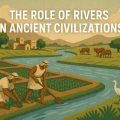Discovering the Majestic Erawan Waterfall in Thailand
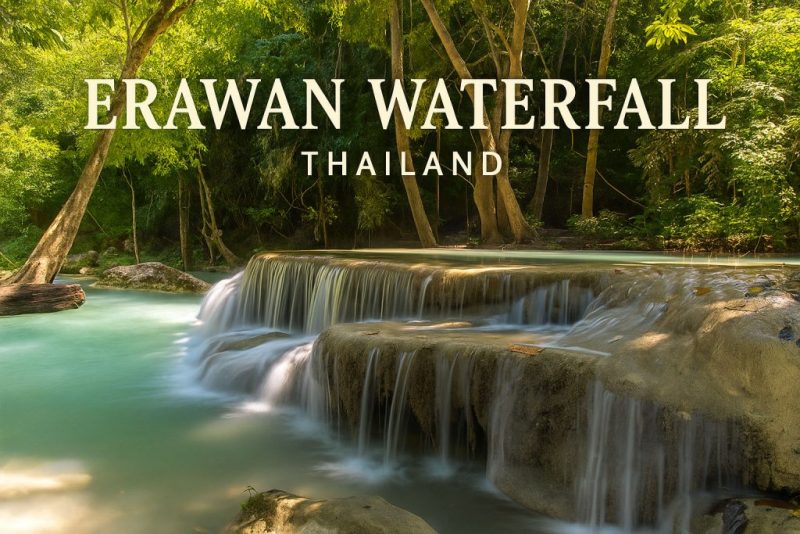
Erawan, a seven-tiered waterfall in Kanchanaburi’s lush jungle, showcases Thailand’s natural beauty with its crystal-clear waters and enchanting charm.
As one of Thailand‘s most iconic natural attractions, Erawan Watrefall offers a mesmerizing blend of scenic splendour and ecological diversity that beckons travellers from across the globe.
The waterfall’s allure extends beyond its visual appeal, providing a sanctuary for both wildlife and nature enthusiasts alike. Each tier of Erawan presents a unique landscape, from tranquil pools perfect for a refreshing dip to thunderous cascades that demonstrate the raw power of nature. The surrounding forest, teeming with exotic flora and fauna, creates an immersive experience that transports visitors into the heart of Thailand’s tropical paradise.
For those seeking adventure and tranquility in equal measure, Erawan is an idyllic destination. The journey through its seven tiers offers not only a physical challenge but also a spiritual connection to the natural world. As visitors ascend the falls, they are treated to ever-changing vistas and the soothing symphony of rushing water, creating memories that linger long after they’ve departed this enchanted realm.
Explore waterfalls in Thailand!
The Legend Behind Erawan Waterfall
The name “Erawan” is steeped in Thai mythology, drawing its origins from Hindu-Buddhist traditions. According to legend, Erawan was a magnificent three-headed elephant of cosmic significance. This celestial creature was said to be the mount of Indra, the king of gods in Hindu mythology. The waterfall’s moniker pays homage to this mythical being, as the cascading tiers are thought to resemble the elephant’s mighty tusks.
Local folklore suggests that the spirit of Erawan resides within the falls, blessing the area with its divine presence. This belief has imbued the site with a sense of reverence and spiritual importance among Thai people. Visitors often report feeling a sense of awe and tranquillity, attributing these sensations to the mythical guardian’s watchful gaze over the natural wonder.
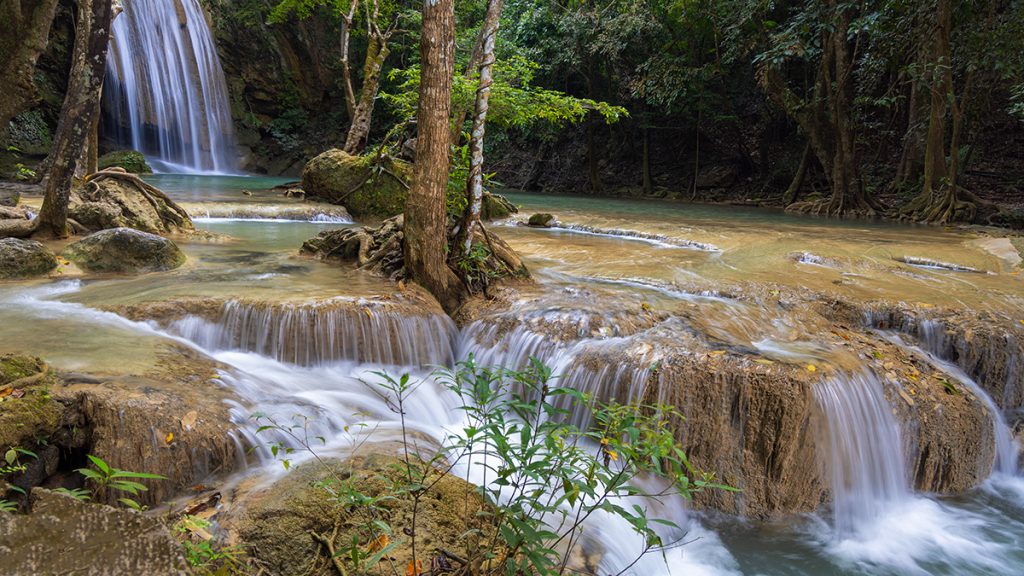
The legend of Erawan has not only named the waterfall but also influenced the cultural landscape of the region. Temples and shrines dedicated to Erawan can be found throughout Thailand, with many pilgrims and tourists alike seeking blessings and good fortune from this revered entity. The waterfall’s mythical associations have thus contributed to its status as not just a natural attraction, but a cultural touchstone that bridges the realms of nature and spirituality.
The Seven Tiers of Erawan: A Closer Look
Erawan’s seven distinct levels offer a diverse array of experiences, each with its own unique character and charm. The journey begins at the easily accessible first tier, where visitors are greeted by a wide, emerald pool surrounded by smooth limestone formations. This level serves as an inviting introduction to the waterfall’s beauty and is often bustling with families and casual visitors enjoying the refreshing waters.
As one ascends to the higher tiers, the landscape becomes increasingly dramatic and less crowded. The second and third tiers feature larger falls and deeper pools, perfect for those seeking a more immersive swimming experience. The fourth tier is renowned for its natural slide, formed by centuries of water erosion, offering thrill-seekers an exhilarating ride down smooth rock faces.
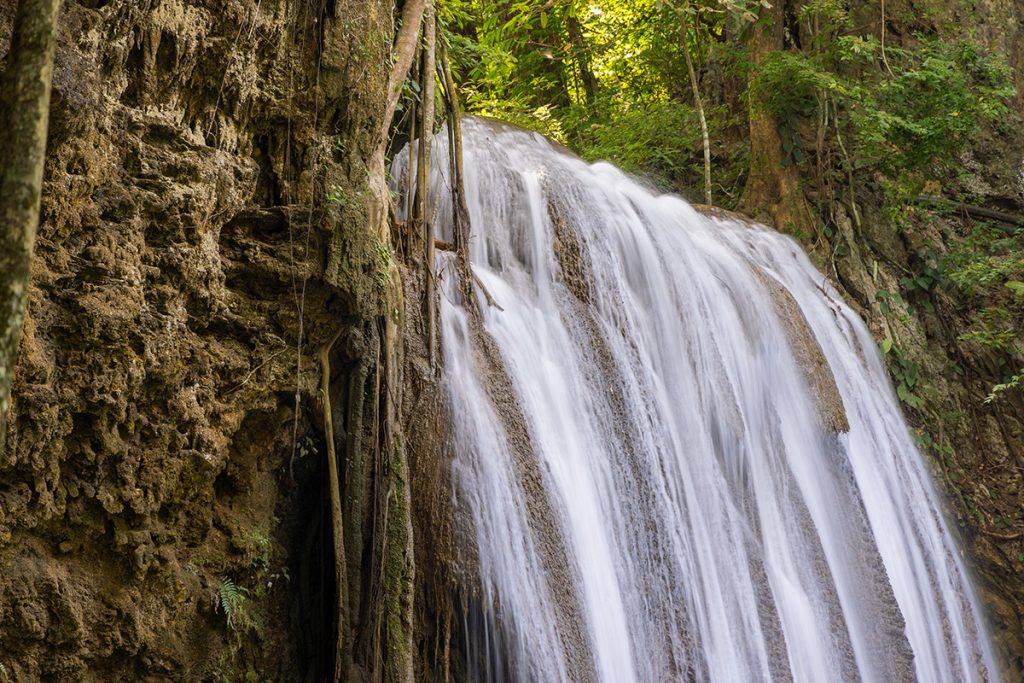
The upper tiers, from the fifth to the seventh, reward intrepid hikers with pristine environments and breathtaking vistas. Their relative seclusion and untouched beauty characterizes these levels. The seventh tier, the pinnacle of the Erawan experience, presents a majestic curtain of water plunging from towering cliffs. This final tier, while challenging to reach, offers unparalleled views and a profound sense of accomplishment for those who make the journey.
Erawan is a large national park, where to fully explore its cascading tiers, take a refreshing swim, and unwind in its serene beauty, you’ll want to dedicate an entire day to immerse yourself in its natural splendor.
Travertine Formations: Nature’s Artistry at Work
One of Erawan’s most distinctive features is its travertine formations, which contribute significantly to the waterfall’s otherworldly beauty. Travertine, a form of limestone deposited by mineral springs, creates the smooth, sculpted terraces and pools that characterize each tier of the falls. This natural process has been ongoing for millennia, resulting in the unique landscapes that visitors marvel at today.
The formation of travertine at Erawan is a delicate and continuous process. As water rich in calcium carbonate flows over the rocks, it deposits thin layers of the mineral. Over time, these layers build up, creating the stepped pools and terraces that give Erawan its distinctive appearance. The process is so gradual that it’s imperceptible to the naked eye, yet over centuries, it has shaped the entire landscape of the waterfall.
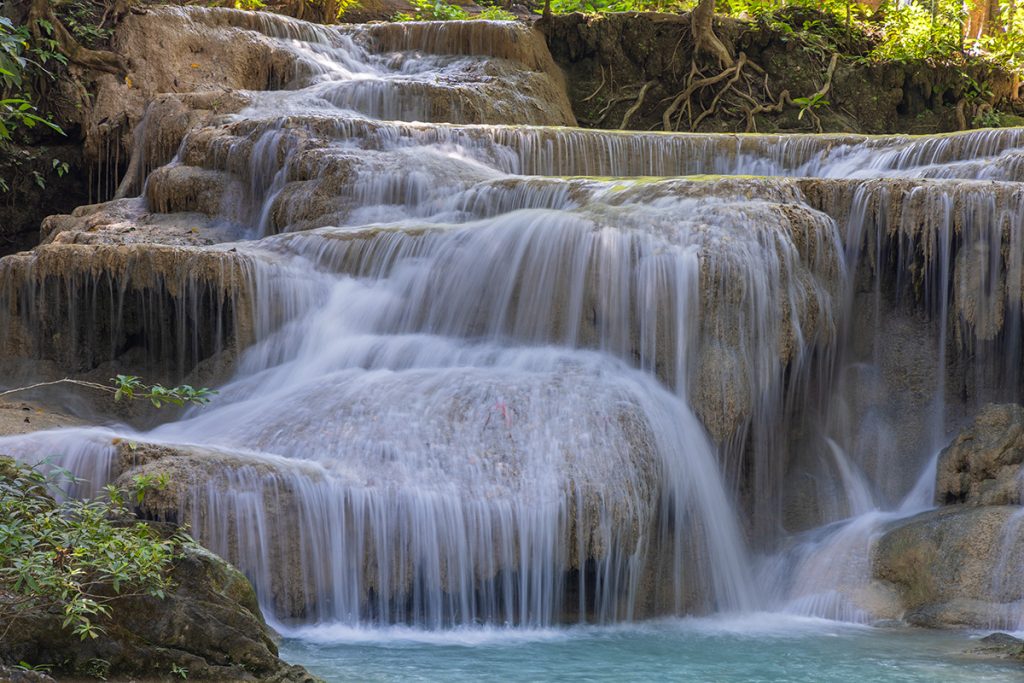
The travertine formations not only contribute to Erawan’s visual appeal but also play a crucial role in its ecosystem. The mineral-rich waters create unique habitats for various aquatic species, including the famous “doctor fish” that nibble on visitors’ feet in some of the pools. Additionally, the porous nature of travertine allows for the growth of diverse plant life, further enhancing the biodiversity of the area.
Flora and Fauna of Erawan National Park
Erawan National Park, which encompasses the famous waterfall, is a haven for biodiversity. The park’s lush forests are home to a wide array of plant species, ranging from towering hardwoods to delicate orchids. Visitors walking through the park may encounter bamboo groves, ferns, and a variety of tropical fruits growing in their natural habitat. This rich flora not only provides a stunning backdrop for the waterfall but also supports a complex ecosystem.
The fauna of Erawan is equally diverse and captivating. The park is home to numerous species of mammals, including elephants, gibbons, and wild boars. Birdwatchers will be delighted by the presence of hornbills, kingfishers, and various species of eagles soaring above the canopy. In the waters of Erawan, several species of fish thrive, including the aforementioned “doctor fish” and larger species in the deeper pools.
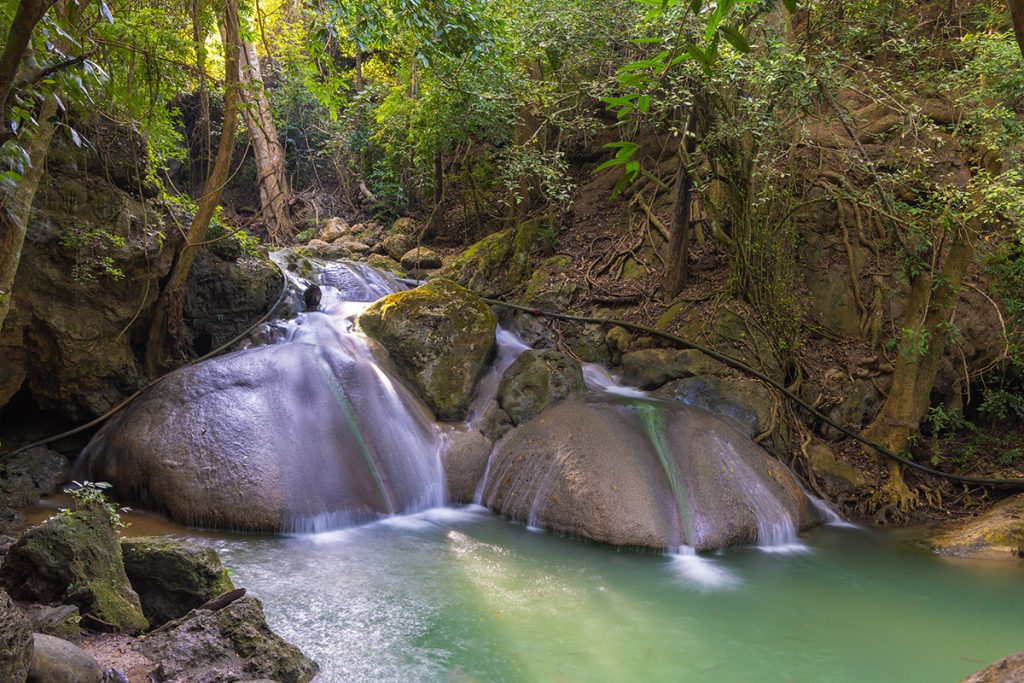
Conservation efforts within the park have helped maintain this rich biodiversity. Park rangers and conservationists work tirelessly to protect endangered species and maintain the delicate balance of the ecosystem. Visitors are encouraged to observe wildlife respectfully and adhere to park guidelines to ensure the continued preservation of this natural wonderland for future generations.
Planning Your Visit to Erawan Waterfall
To make the most of a trip to Erawan, careful planning is essential. The waterfall is located approximately 200 kilometres northwest of Bangkok, making it accessible for a day trip or as part of a longer exploration of Kanchanaburi Province, not very far from Kwai River and it famous bridge. Visitors can reach the park by public bus, private car, or organized tour, with each option offering different levels of flexibility and convenience.
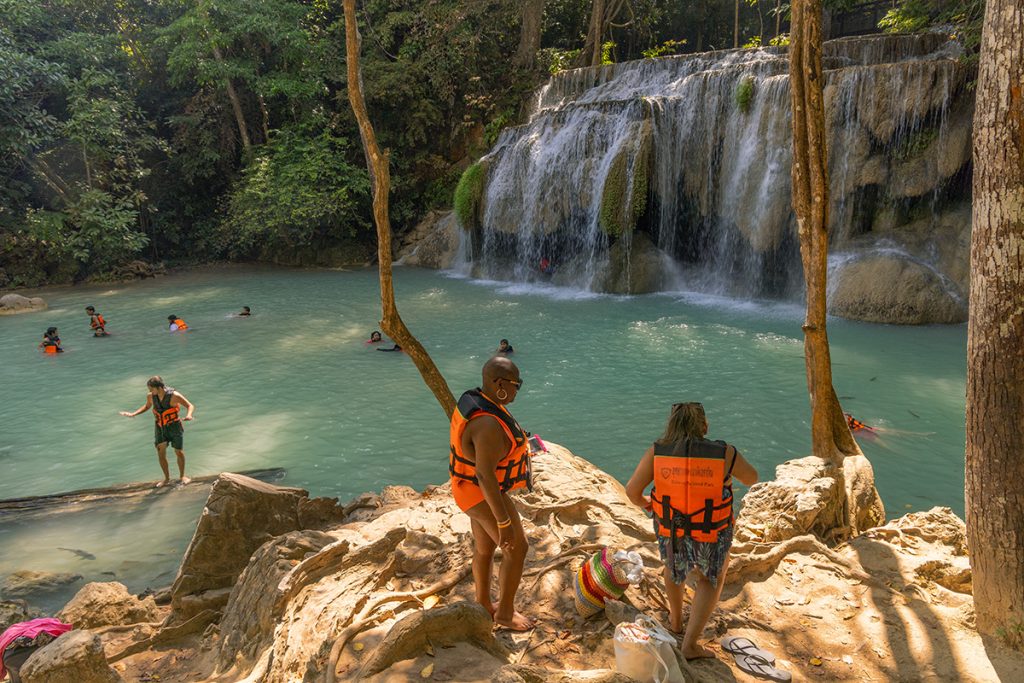
When packing for Erawan, it’s important to come prepared for both hiking and swimming. Sturdy walking shoes are a must for navigating the sometimes slippery trails, especially on higher tiers. Swimwear and a towel are essential for enjoying the inviting pools. Visitors should also bring sunscreen, insect repellent, and plenty of water to stay comfortable throughout their adventure.
The park offers various amenities to enhance the visitor experience. At the entrance, there’s a visitor centre providing maps and information about the waterfall and surrounding area. Several food stalls and restaurants near the lower tiers offer local Thai cuisine and refreshments. For those wishing to extend their stay, the park provides camping facilities and bungalows, allowing for a more immersive experience in this natural paradise.
Best Times to Experience Erawan’s Beauty
The beauty of Erawan can be appreciated year-round, but certain seasons offer distinct advantages. The dry season, typically from November to April, is generally considered the best time to visit. During these months, the water levels are lower, making it easier to navigate the trails and swim in the pools. The weather is also more predictable, with clear skies providing ideal conditions for photography and sightseeing.
However, the rainy season, from May to October, shouldn’t be discounted. While there’s a higher chance of precipitation, this period also brings lush greenery and powerful water flow, showcasing Erawan at its most dramatic. The falls are particularly spectacular immediately after a heavy rain when the cascades are at their fullest. Visitors during this season should be prepared for sudden showers and potentially slippery conditions on the trails.
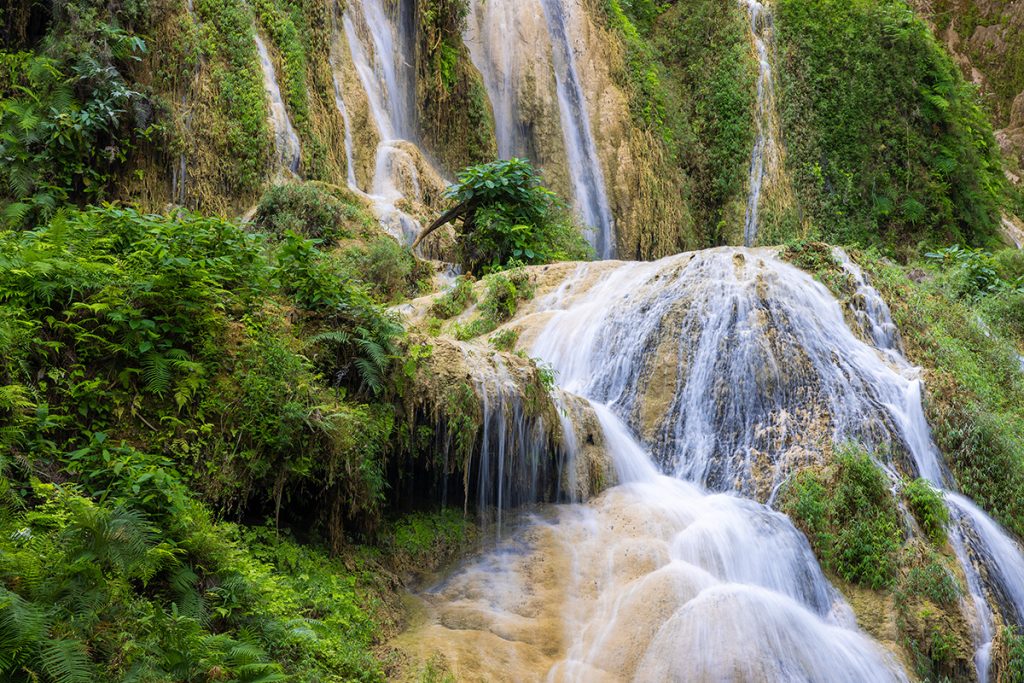
For those seeking a balance between good weather and smaller crowds, the shoulder seasons of early November and late April can be ideal. These periods often offer pleasant weather conditions while avoiding the peak tourist influx. Regardless of the season, early morning visits are recommended to beat the heat and crowds, allowing for a more serene experience of Erawan’s natural splendour.
Swimming and Trekking at Erawan: What to Expect
Swimming is one of the main attractions at Erawan, with each tier offering unique aquatic experiences. The lower tiers feature wide, shallow pools perfect for leisurely swims and family-friendly splashing. As visitors ascend, they’ll encounter deeper pools with crystal-clear waters, ideal for more adventurous swimming and even cliff jumping in designated areas. The famous “doctor fish” can be found in several pools, offering a natural spa treatment as they gently nibble on swimmers’ skin.
Trekking through Erawan is an adventure in itself. The trail to the top tier is approximately 1.5 kilometres long and varies in difficulty. The path to the first three tiers is relatively easy and well-maintained, suitable for most visitors. Beyond the third tier, the trail becomes more challenging, with steeper inclines and natural obstacles. Hikers should be prepared for a moderate to strenuous trek, especially when aiming for the upper tiers.
Safety is paramount when enjoying Erawan’s natural attractions. Visitors should adhere to all posted signs and guidelines, wear appropriate footwear for slippery surfaces, and never swim alone or in restricted areas. The park provides life jackets for swimmers, which are particularly recommended for children and less confident swimmers. By respecting the environment and following safety protocols, visitors can fully immerse themselves in the wonder of Erawan while ensuring their well-being.
Conservation Efforts at Erawan National Park
Erawan National Park is at the forefront of conservation efforts in Thailand, working tirelessly to preserve its unique ecosystem for future generations. Park authorities have implemented strict regulations to protect the delicate balance of flora and fauna within the park’s boundaries. These measures include limiting the number of daily visitors, enforcing no-littering policies, and restricting certain activities that could harm the environment.
One of the key conservation initiatives focuses on protecting the travertine formations that give Erawan its distinctive character. Visitors are educated about the fragility of these structures and are prohibited from climbing or walking on the travertine terraces. Additionally, the use of sunscreen and other chemicals is restricted in certain areas to prevent contamination of the water and damage to the aquatic ecosystem.
The park also engages in ongoing research and monitoring programs to track the health of its ecosystems. These efforts include studying the populations of native species, monitoring water quality, and assessing the impact of tourism on the environment. By gathering this data, park managers can make informed decisions about conservation strategies and adapt their approaches as needed to ensure the long-term sustainability of Erawan’s natural wonders.
Nearby Attractions: Extending Your Thai Adventure
While Erawan is undoubtedly a highlight of any visit to Kanchanaburi Province, the surrounding area offers numerous attractions that can enrich a traveller’s experience. Just a short distance from the waterfall, history buffs can explore the infamous Burma Railway, also known as the Death Railway, and the poignant Hellfire Pass Memorial Museum. These sites offer a sobering glimpse into the region’s World War II history and serve as important reminders of the past.
Nature enthusiasts can continue their exploration at nearby Sai Yok National Park, home to its own set of waterfalls and limestone caves. The park also offers opportunities for river rafting and spotting wildlife such as gibbons and hornbills. For a cultural experience, visitors can head to the town of Kanchanaburi to visit temples, markets, and the famous Bridge over the River Kwai.
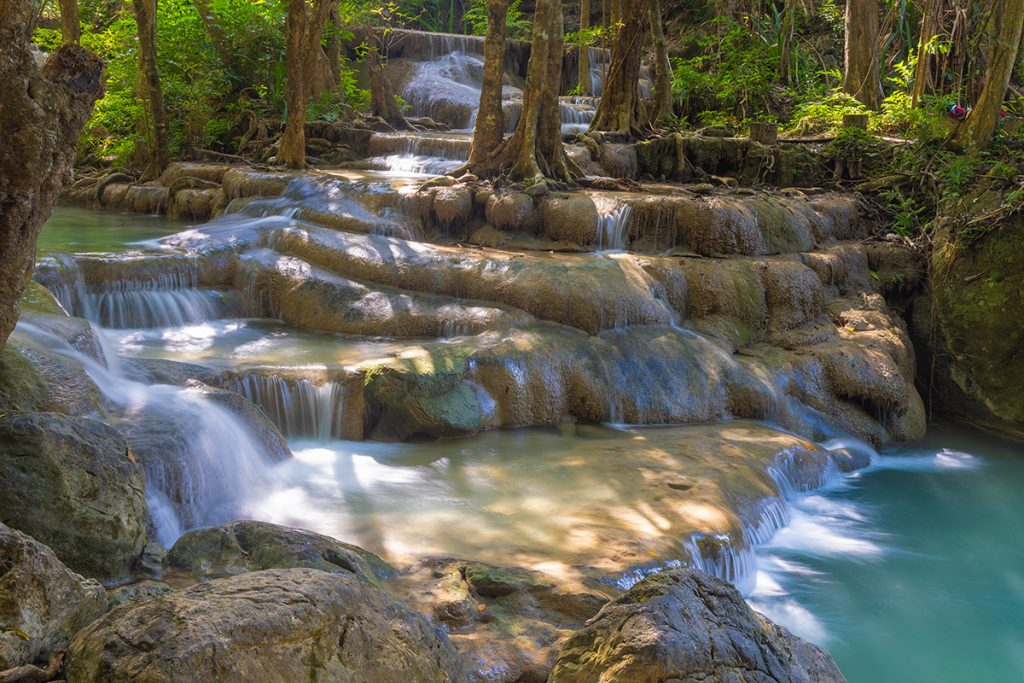
Those seeking a more immersive experience can consider staying at one of the many eco-lodges or floating raft houses along the River Kwai. These accommodations offer a unique perspective on the region’s natural beauty and often provide activities such as kayaking, traditional cooking classes, and guided jungle treks. By combining a visit to Erawan with these nearby attractions, travellers can gain a deeper appreciation for the diverse offerings of Kanchanaburi Province.
Conclusion: Why Erawan Should Top Your Thailand Itinerary
Erawan Waterfall stands as a testament to the raw beauty and natural wonders that Thailand has to offer. Its seven tiers of cascading waters, set against a backdrop of lush jungle and limestone formations, create a paradise that seems almost too perfect to be real. The combination of stunning visuals, rich biodiversity, and the opportunity for both relaxation and adventure makes Erawan a must-visit destination for any traveller to Thailand.
Beyond its aesthetic appeal, Erawan offers visitors a chance to connect with nature in a profound way. The journey through its tiers is not just a physical trek but a sensory experience that engages all aspects of one’s being. The sound of rushing water, the feel of cool mist on one’s skin, and the sight of sunlight filtering through the canopy create memories that linger long after the visit has ended.
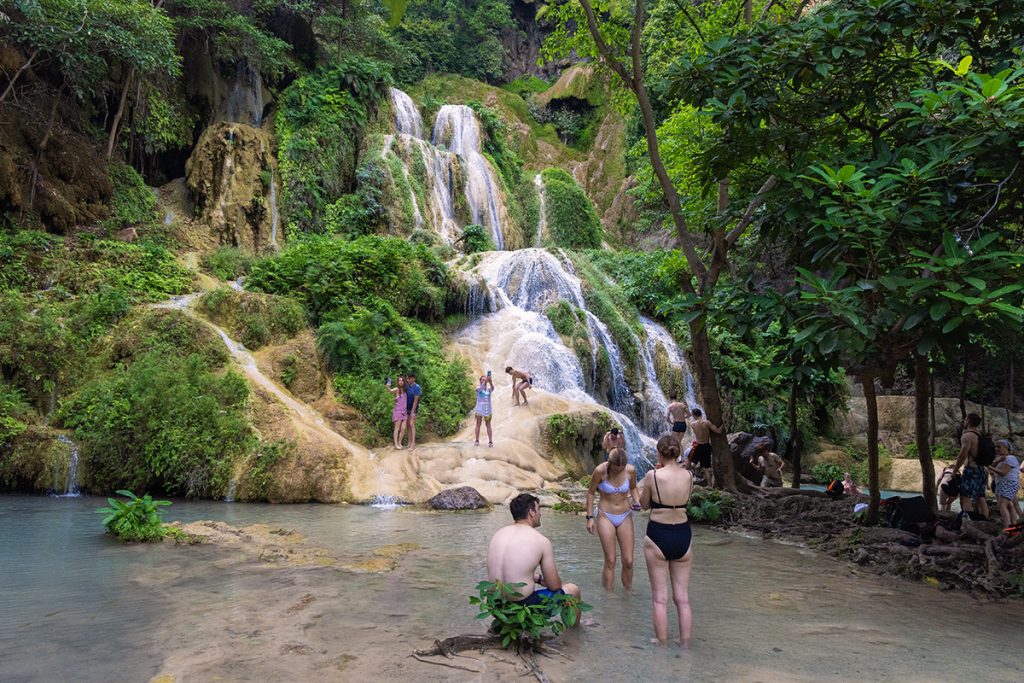
As travellers seek authentic experiences and connections with the natural world, Erawan provides a perfect blend of accessibility and unspoiled beauty. It serves as a reminder of the importance of conservation and the delicate balance between human enjoyment and environmental protection. A visit to Erawan is not just a trip to a waterfall; it’s an opportunity to witness the majesty of nature, to challenge oneself, and to gain a deeper appreciation for the wonders of our planet.
Ready to embark on your own Erawan adventure? Don’t miss the chance to experience this natural wonder firsthand. Book your trip to Kanchanaburi today and prepare to be enchanted by the magic of Erawan Waterfall. Remember to pack your sense of adventure, respect for nature, and a camera to capture the memories of a lifetime!


